Final year project
City in Architecture (CiA) - The New TANG [Read more]
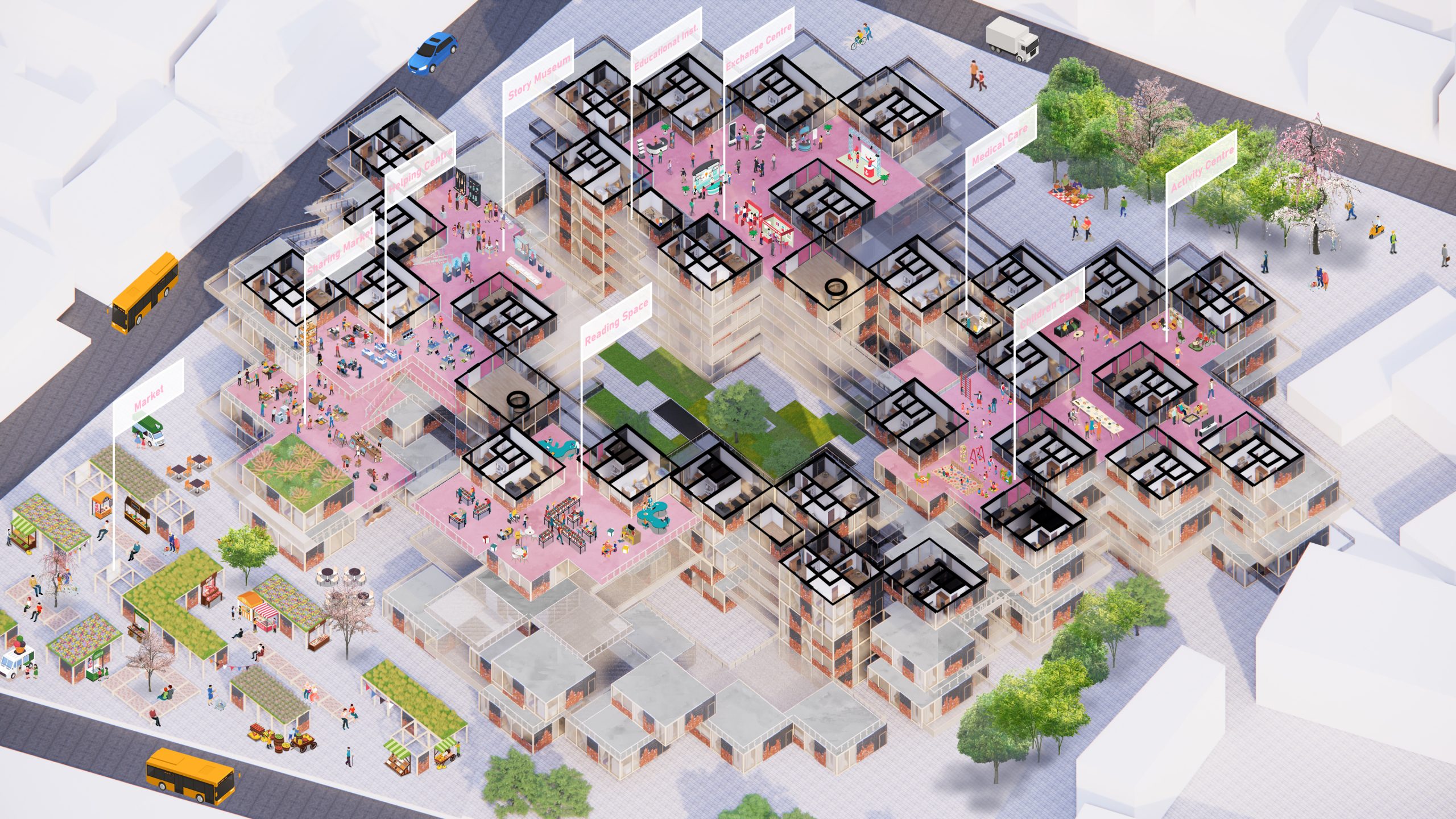
The New TANG Stage II
In this stage of CiA I would like to focus on the specific groups of people currently living in Longtang, listening to their needs and the dilemmas they face during the rapid urbanisation. Hence, I would like to investigate the composition of people living on the site. By understanding the history of Longtang, I found that Longtang is firstly designed for middle or even high social status groups in Shanghai. However, most of them moved away from Longtang to better-living space in Shanghai during the Chinese economic reform. After 1978, more and more lower social status groups moved into Longtang, forming the current special social groups in Longtang. Therefore, when people look at the Longtang today, two very important social groups need to be considered. The first one is the migrant workers, who chose to move to Shanghai to make money since 1990. The other one is the elderly, specifically those senior citizens living alone in this area.
My project is about striking a balance where I design the government wants to do, providing a number of flats to accommodate around 600 people in the original region. But at the same time, I am also trying yo find a way to create sufficient community space providing a large variety of services to the residents, especially the two special groups.
The current situation is that the three groups of people (two special groups and other locals) living separately. Although they are in the same community, there is little contact between them, which leads to the result that they do not have much emotional attachment to the community and their neighbours. I want to establish an assistance cycle where each group of people can use their advantages and resources to help the other groups. In this cycle, the government is also an essential role that needs to be considered, providing extra resources to the community.
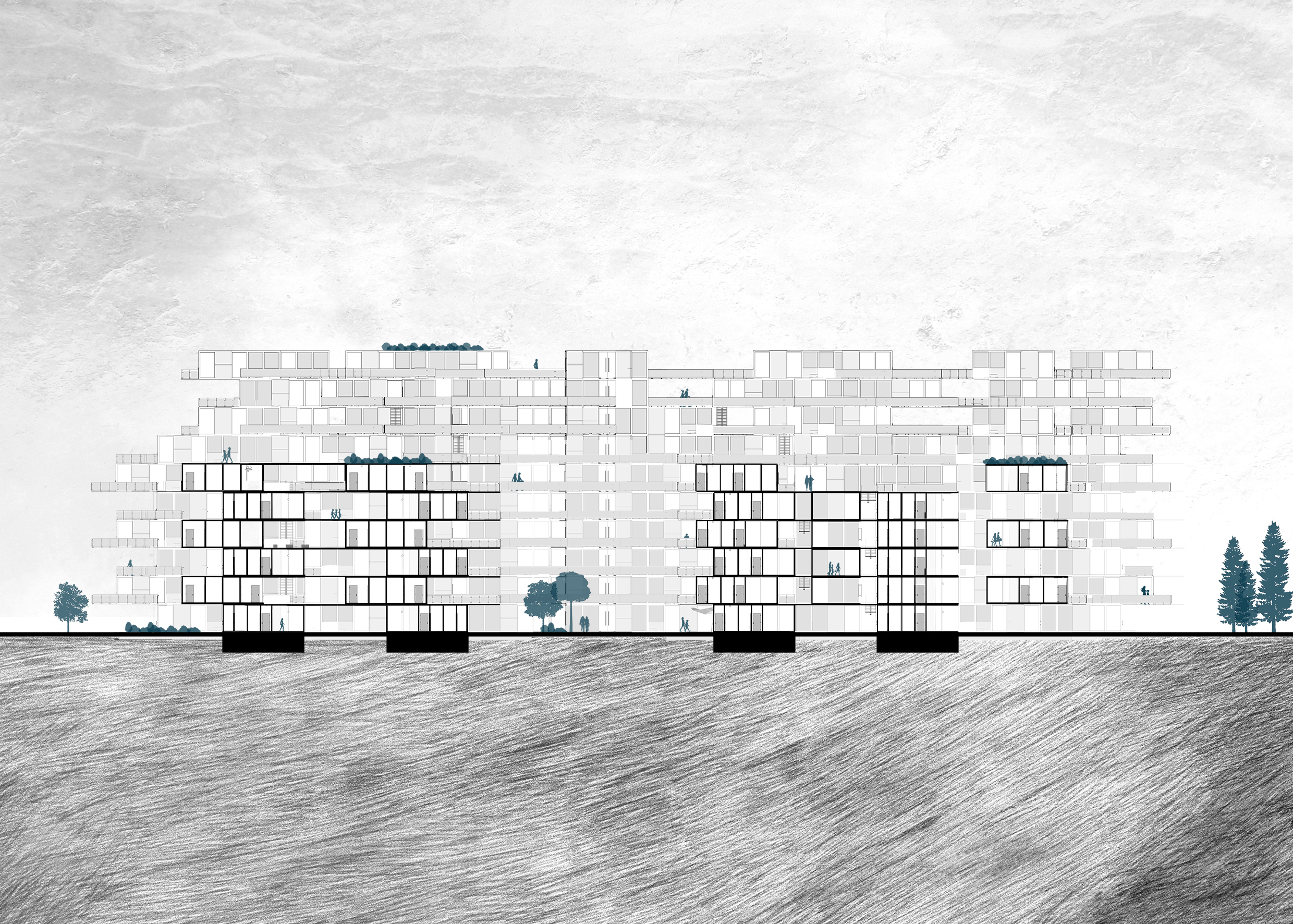

The New TANG Stage II Section
In this stage of CiA I would like to focus on the specific groups of people currently living in Longtang, listening to their needs and the dilemmas they face during the rapid urbanisation. Hence, I would like to investigate the composition of people living on the site. By understanding the history of Longtang, I found that Longtang is firstly designed for middle or even high social status groups in Shanghai. However, most of them moved away from Longtang to better-living space in Shanghai during the Chinese economic reform. After 1978, more and more lower social status groups moved into Longtang, forming the current special social groups in Longtang. Therefore, when people look at the Longtang today, two very important social groups need to be considered. The first one is the migrant workers, who chose to move to Shanghai to make money since 1990. The other one is the elderly, specifically those senior citizens living alone in this area.
My project is about striking a balance where I design the government wants to do, providing a number of flats to accommodate around 600 people on the original region. But at the same time, I am also trying yo find a way to create sufficient community space providing a large variety of services to the residents, especially the two special groups.
The current situation is that the three groups of people (two special groups and other locals) living separately. Although they are in the same community, there is little contact between them, which leads to the result that they do not have much emotional attachment to the community and their neighbours. I want to establish an assistance cycle where each group of people can use their advantages and resources to help the other groups. In this cycle, the government is also an essential role that needs to be considered, providing extra resources to the community.
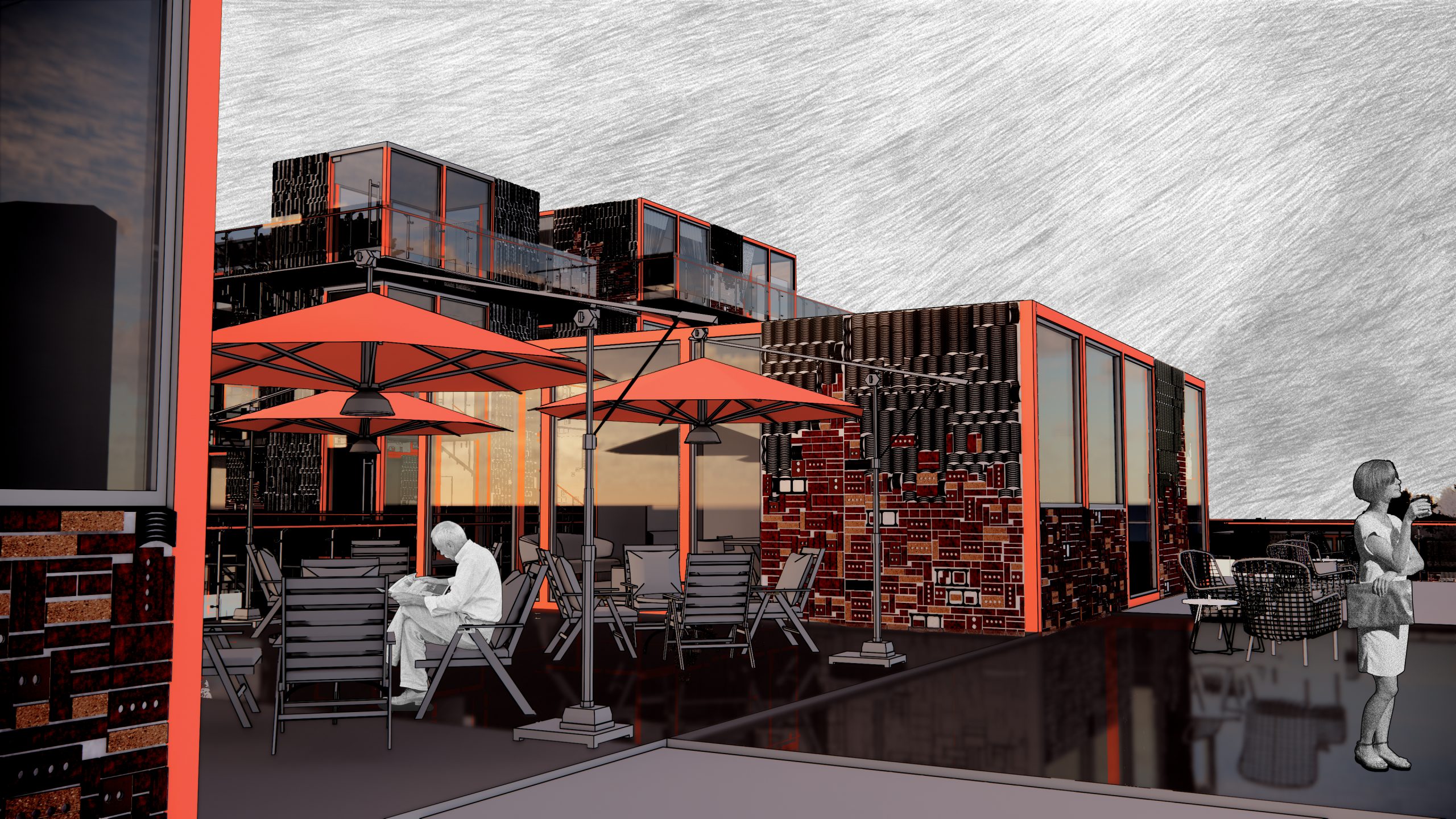

The New TANG Stage II Exterior
In this stage of CiA I would like to focus on the specific groups of people currently living in Longtang, listening to their needs and the dilemmas they face during the rapid urbanisation. Hence, I would like to investigate the composition of people living on the site. By understanding the history of Longtang, I found that Longtang is firstly designed for middle or even high social status groups in Shanghai. However, most of them moved away from Longtang to better-living space in Shanghai during the Chinese economic reform. After 1978, more and more lower social status groups moved into Longtang, forming the current special social groups in Longtang. Therefore, when people look at the Longtang today, two very important social groups need to be considered. The first one is the migrant workers, who chose to move to Shanghai to make money since 1990. The other one is the elderly, specifically those senior citizens living alone in this area.
My project is about striking a balance where I design the government wants to do, providing a number of flats to accommodate around 600 people on the original region. But at the same time, I am also trying yo find a way to create sufficient community space providing a large variety of services to the residents, especially the two special groups.
The current situation is that the three groups of people (two special groups and other locals) living separately. Although they are in the same community, there is little contact between them, which leads to the result that they do not have much emotional attachment to the community and their neighbours. I want to establish an assistance cycle where each group of people can use their advantages and resources to help the other groups. In this cycle, the government is also an essential role that needs to be considered, providing extra resources to the community.
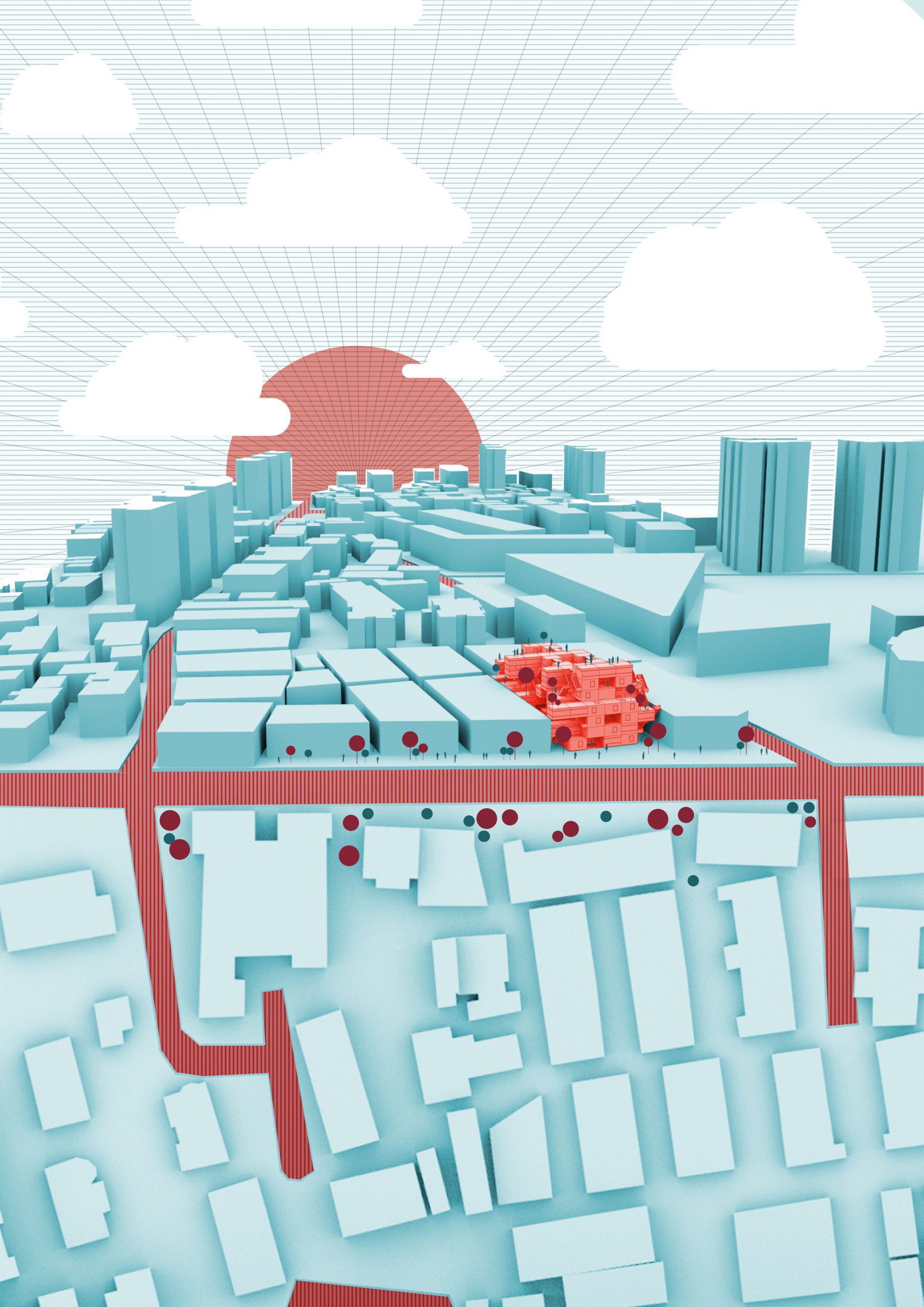

The New TANG Stage I - Site plan and Exterior perspective
The problem I investigate in CiA is about the rapid urbanisation. Rapid urbanisation leads to a large number of serious issues, such as pollution, greater gap of wealth, waste problems and so on. Among all of them, the problem which draws my attention is the clash between old towns and new towns. The city I picked is Shanghai which is my hometown and the city is also caught in this dilemma. A kind of traditional community, which is called Longtang, is vanishing. The Longtang I picked for my second stage of CiA is called Bugaoli. One of my uncles is living there and I’ve visited the place many times. Therefore, I am quite familiar with it. There are an increasing number of high rise modern apartments built next to Bugaoli in recent years. Bugaoli is also classified into Shanghai urban planning project and will be removed and replaced by one of those simple, typical high rise modern apartments. However, the unique characteristics of Longtang cannot be represented by the newly built modern homes but they deserve to be preserved. So I’ve decided to transplant those valuable features into my new TANG.
Longtang is built for the sake of solving the accommodation problems in Shanghai in the early 20th century. Normally, each housing unit is designed for 2-3 households, but usually has to accommodate 5 to 6 of them. Hence, the average living space per person is around 4-8 square meters, which is much lower than the average number of Shanghai and other developed cities all over the world. The lack of space leads to low living standard. For example, the average sunshine time in Longtang is much shorter than in a normal Shanghai high rise apartment.Besides, the ventilation is poor as well, due to the limited width of the lane and the high density of houses.
However, the small house size inadvertently created a pretty valuable community culture. As someone who used to live there, I can tell you that life in Longtang is utterly special. The community culture, traditional food making methods, space transformation, temporary store, all of them are unique. There is a Chinese proverb that sums up the community in Longtang: Good neighbours are more helpful than far away relatives.
The reason why the unique community is formed is because of the special architectural spatial feature in Longtang, which is the limited personal space. One of the results of it is that the inhabitants are forced to go outside and interact more. The other one is people trying to have more types of space catering to different purposes, so they partition the limited space to create a large diversity of space. Both of these two results help to develop the special community culture in Longtang.
In conclusion, I try to preserve the community in the new TANG by remaining the diversity of space generated in Longtang.
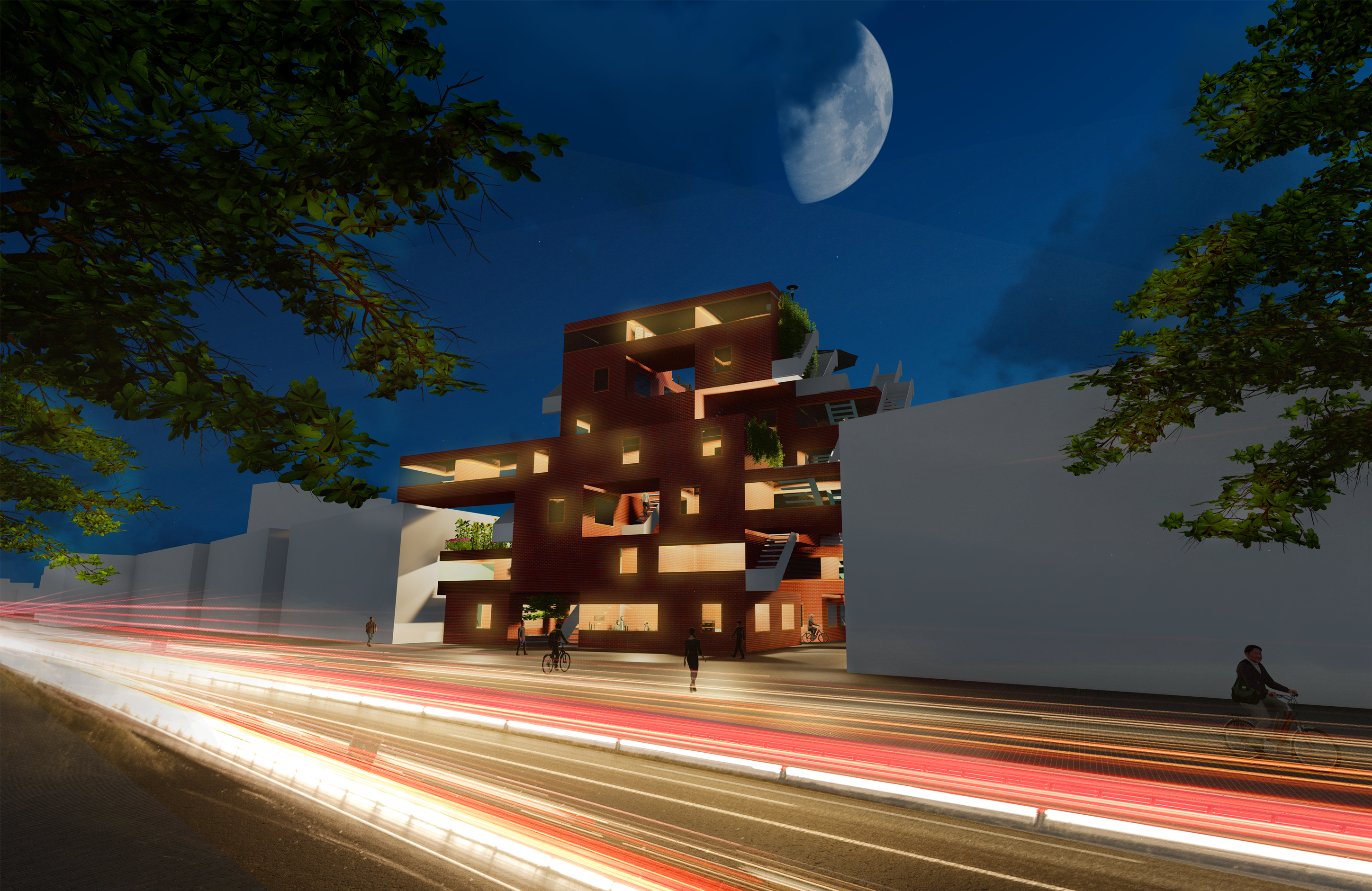

The New TANG Stage I
The problem I investigate in CiA is about the rapid urbanisation. Rapid urbanisation leads to a large number of serious issues, such as pollution, a greater gap of wealth, waste problems and so on. Among all of them, the problem which draws my attention is the clash between old towns and new towns. The city I picked is Shanghai which is my hometown and the city is also caught in this dilemma. A kind of traditional community, which is called Longtang, is vanishing. The Longtang I picked for my second stage of CiA is called Bugaoli. One of my uncles is living there and I’ve visited the place many times. Therefore, I am quite familiar with it. There are an increasing number of high rise modern apartments built next to Bugaoli in recent years. Bugaoli is also classified into Shanghai urban planning project and will be removed and replaced by one of those simple, typical high rise modern apartments. However, the unique characteristics of Longtang cannot be represented by the newly built modern homes but they deserve to be preserved. So I’ve decided to transplant those valuable features into my new TANG.
Longtang is built for the sake of solving the accommodation problems in Shanghai in the early 20th century. Normally, each housing unit is designed for 2-3 households but usually has to accommodate 5 to 6 of them. Hence, the average living space per person is around 4-8 square meters, which is much lower than the average number of Shanghai and other developed cities all over the world. The lack of space leads to low living standard. For example, the average sunshine time in Longtang is much shorter than in a normal Shanghai high rise apartment. Besides, the ventilation is poor as well, due to the limited width of the lane and the high density of houses.
However, the small house size inadvertently created a pretty valuable community culture. As someone who used to live there, I can tell you that life in Longtang is utterly special. The community culture, traditional food making methods, space transformation, temporary store, all of them are unique. There is a Chinese proverb that sums up the community in Longtang: Good neighbours are more helpful than far away relatives.
The reason why the unique community is formed is because of the special architectural spatial feature in Longtang, which is the limited personal space. One of the results of it is that the inhabitants are forced to go outside and interact more. The other one is people trying to have more types of space catering to different purposes, so they partition the limited space to create a large diversity of space. Both of these two results help to develop the special community culture in Longtang.
In conclusion, I try to preserve the community in the new TANG by remaining the diversity of space generated in Longtang.
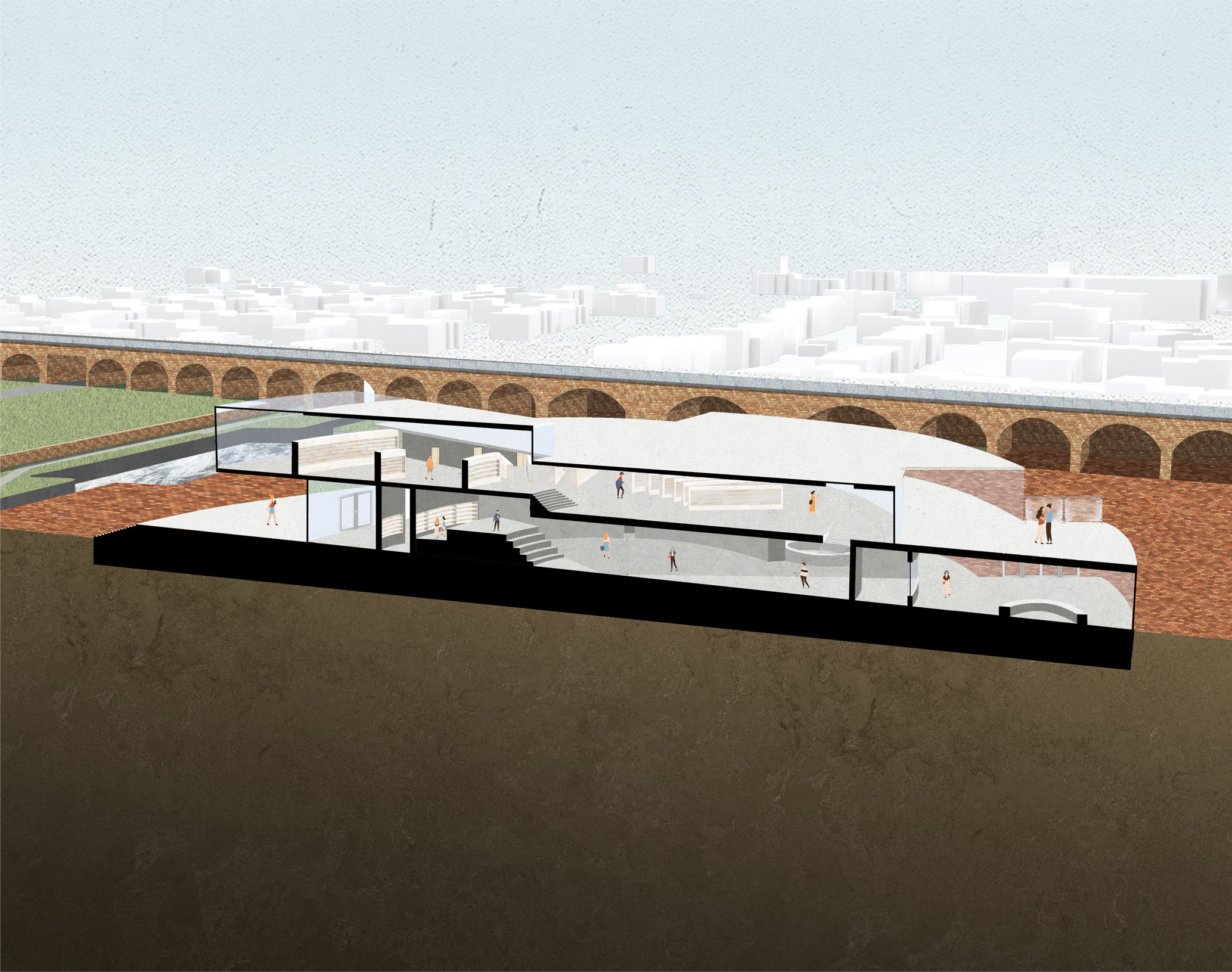

Exclusion&Inclusion - Perspective section
While more than 90 per cent of Liverpool’s population is white, the city is one of the most important sites in the history of multiculturalism in the United Kingdom. The immigrants with different cultural background bring their traditions and culture into the city of Liverpool. Meanwhile, the government also built plenty of communities and buildings which represent the culture of one of the regions in order to give the immigrants a sense of belonging and
attract more foreigners to visit the city. However, both methods may cause misunderstanding to the local and other ethnic groups. All these inappropriate ways build up boundaries between different ethnic groups. So the library is going to break boundaries, to bring those that are “excluded” to be “included”.
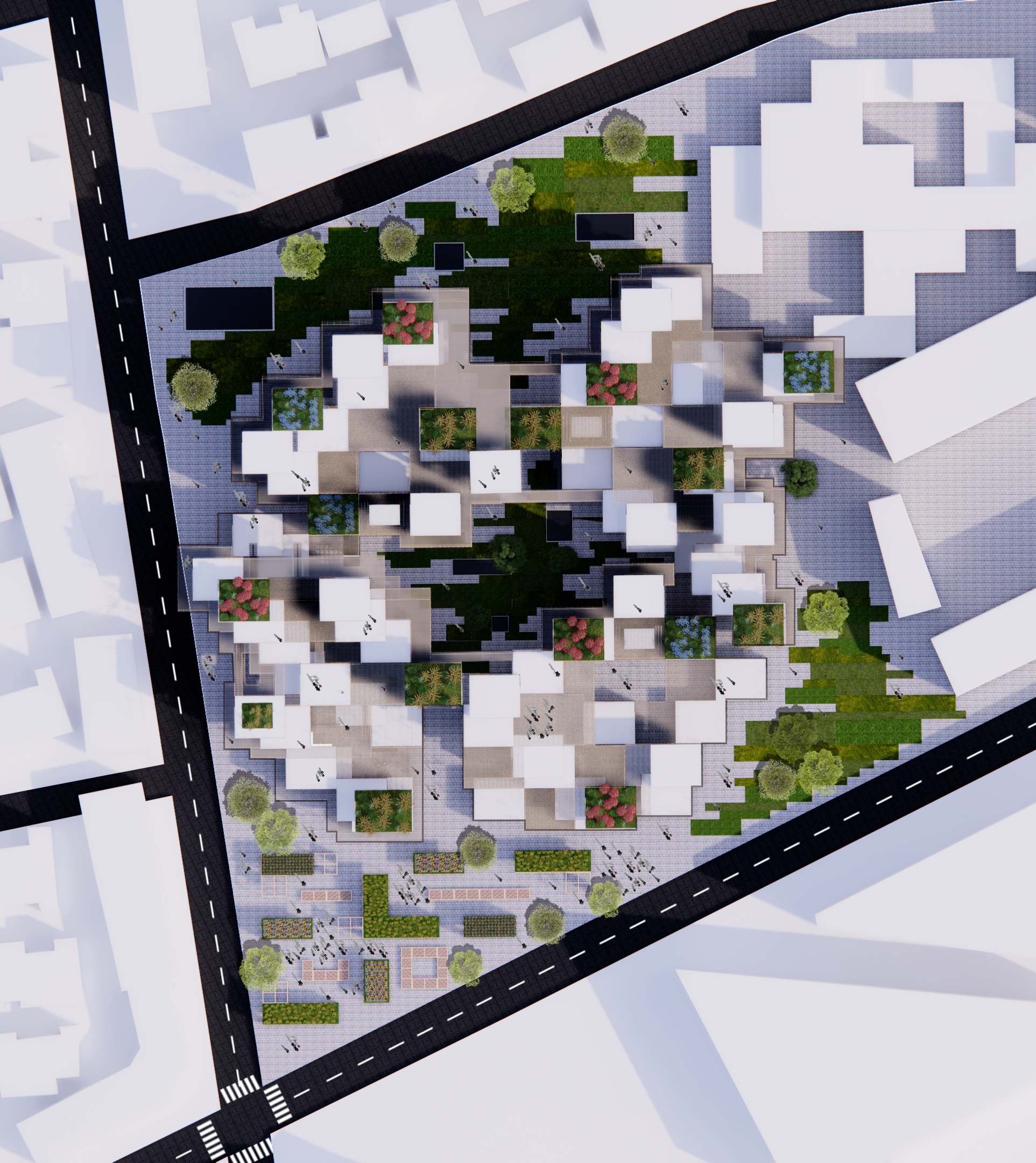

The New TANG Stage II Site Plan
In this stage of CiA I would like to focus on the specific groups of people currently living in Longtang, listening to their needs and the dilemmas they face during the rapid urbanisation. Hence, I would like to investigate the composition of people living on the site. By understanding the history of Longtang, I found that Longtang is firstly designed for middle or even high social status groups in Shanghai. However, most of them moved away from Longtang to better-living space in Shanghai during the Chinese economic reform. After 1978, more and more lower social status groups moved into Longtang, forming the current special social groups in Longtang. Therefore, when people look at the Longtang today, two very important social groups need to be considered. The first one is the migrant workers, who chose to move to Shanghai to make money since 1990. The other one is the elderly, specifically those senior citizens living alone in this area.
My project is about striking a balance where I design the government wants to do, providing a number of flats to accommodate around 600 people on the original region. But at the same time, I am also trying yo find a way to create sufficient community space providing a large variety of services to the residents, especially the two special groups.
The current situation is that the three groups of people (two special groups and other locals) living separately. Although they are in the same community, there is little contact between them, which leads to the result that they do not have much emotional attachment to the community and their neighbours. I want to establish an assistance cycle where each group of people can use their advantages and resources to help the other groups. In this cycle, the government is also an essential role that needs to be considered, providing extra resources to the community.
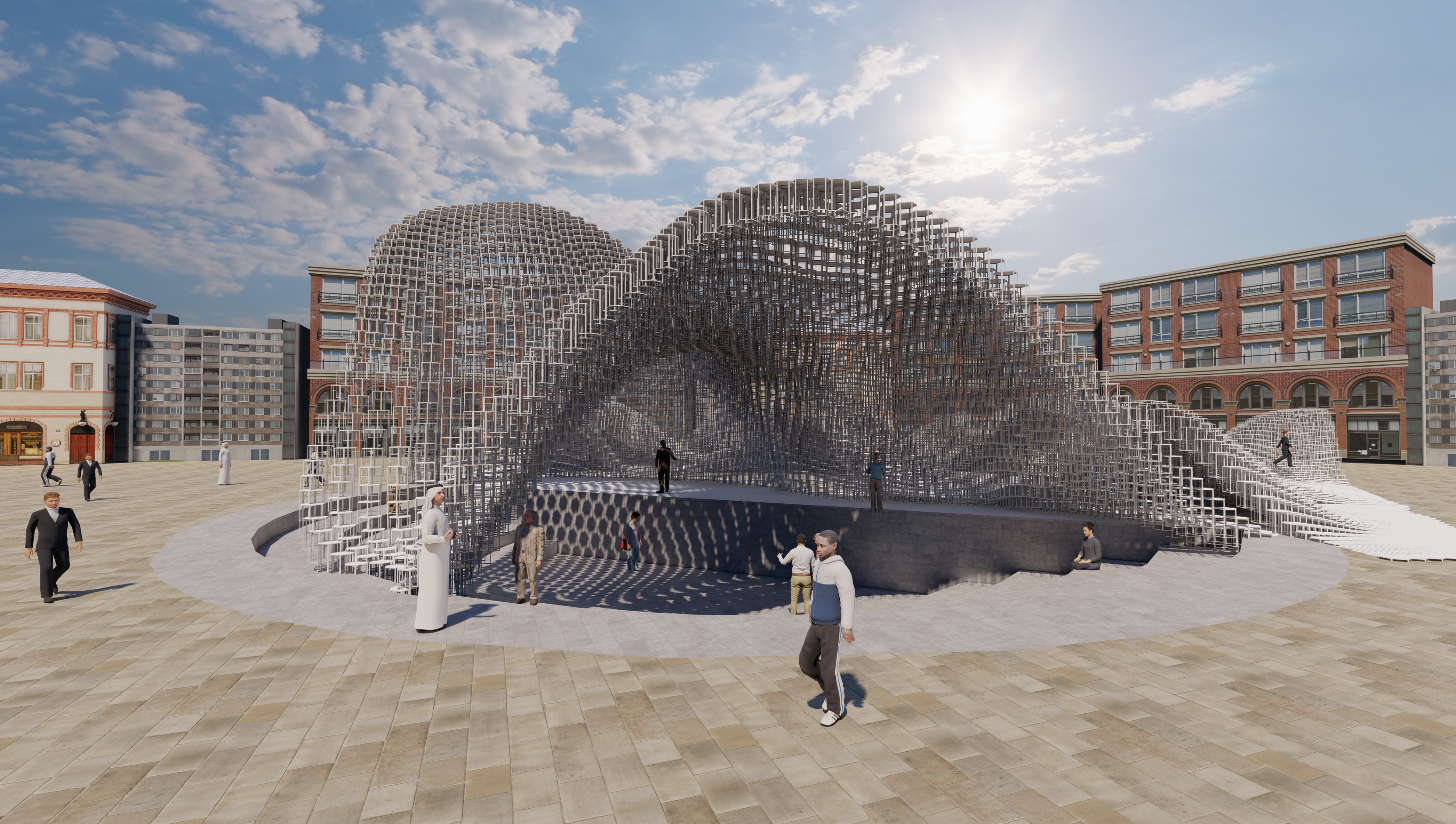

Guerilla Architecture
Over 700,000 immigrants who are currently living in the UK, 1/3 of them are overqualified for their job. Through research and personal experience, we have identified a missing link between migrant workers and the contacts or facilities they need in order to be placed in the correct job for them. Our programme provides immigrants with foreign qualification and professional skills the opportunity to pursue a career in their field in the UK. We see them through the job-seeking process to ensure they achieve the goals they are aiming for and can be in their professional field. The three pillars of our concept are the recognition of skills of migrant workers, providing equal opportunity of jobs and in turn increasing the representation and celebration of culture, all through a playful intervention that encourages the interaction and assimilation of immigrants in the UK.
Ziyang Wang
I am an international student from China, studying Part 1 Architecture. The problem I investigate in CiA is about rapid urbanisation. Rapid urbanisation leads to a large number of serious issues, such as pollution, greater gap of wealth, waste problems and so on. Among all of them, the problem which draws my attention is the clash between old town and new town.
I am good at a wide range of computer programs, including 3D modelling software (Rhino, Sketchup and Revit), rendering tools (Lumion and Enscape), Photoshop, Illustrator and Indesign. Besides, I am skilled in the presentation to communicate my ideas with the clients as well. My English is fluent, with an overall 7.0 IELTS score. I’m also interested in sketching buildings with pencils and liners. I aim to be an experienced architect in the UK in the future.
Final year project
City in Architecture (CiA) - The New TANG
Work Experience
I was employed as an architectural assistant in Murphy Philipps from September 2019. I worked on a range of healthcare schemes, from £500,000 to £150m. I also undertook presentation work, preparing loaded 1:50 information as well as supporting planning applications and 1:200 layouts using a range of computer programs.
I contracted with a company named Yeeyan to be a translator. My work is to translate some English novels into Chinese. Now I am collaborating with a senior translator to translate one of Maugham’s most famous works Of Human Bondage.